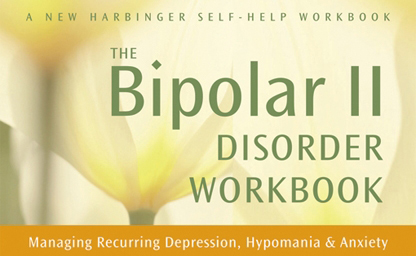Editor's Note: This is part one of a two-part Q&A with Stephanie Roberts, PhD, co-author of The Bipolar II Disorder Workbook.
What are the key differences between bipolar I and bipolar II?
At first, it may seem difficult to see the difference between bipolar I (BDI) and bipolar II (BDII). However, a simple rule of thumb is to associate BDI with mania and BDII with hypomania. This is because the key difference between BDI and BDII is that people with BDII never have a manic episode. Instead they experience hypomanic episodes. Hypomania is characterized by a persistently irritable, elevated, or expansive mood. This type of mood must be accompanied by several other symptoms such as abnormally high self-esteem, a decreased need for sleep or feeling more talkative. Most people do not realize this, but the symptoms of mania are actually identical to those of hypomania. However, they differ in that compared with manic episodes, hypomanic episodes do not impair social or occupational functioning. Furthermore, to be diagnosed with BDII, the individual must have experienced a hypomanic episode in addition to a depressive episode. To be diagnosed with BDI, the individual must have experienced at least one manic episode. Although most individuals with BDI experience depressive episodes in addition to manic episodes, a depressive episode is not required for the BDI diagnosis.
What is the role of acceptance in treating BDII?
The notion of acceptance can play an important role for people with bipolar II disorder. Having BDII is not easy; in fact at times, it can make life feel very difficult and frustrating. However, BDII is not something that one can simply ignore or snap their fingers and turn off, so it is important to recognize BDII for what it is—an illness—and to manage it accordingly. Acceptance is just that: recognizing a situation for what it is. Most people do not like living with BDII, however, if they deny they have the illness (and hence do not practice acceptance) they may find it even harder to cope. Remember that practicing acceptance does not mean that a person likes having BDII, it just means that she acknowledges its presence and impact on her life. Practicing acceptance allows people with BDII to get the help and the support that they need to take good care of themselves.
What are common triggers for depressive or manic episodes, and how can people learn to identify theirs?
There are many types of triggers for depression. Common ones are a type of loss, such as the death of a loved one or even the loss of a job, as well as financial and relationship stressors. Furthermore, changes to one’s routine or schedule or the use of alcohol or drugs can serve as triggers. In addition, triggers for depression may actually be events that most people would think of as happy events, such as getting married or having a new baby. Indeed, the high stress associated with these types of events can play a role in triggering depression, especially for a person that already has a history of depression. People can identify their triggers for depression when they first start noticing symptoms of depression. They can then consider recent life events and changes and see if there may be a relationship. Alternatively, people who keep a journal or a diary may find that that is a good way to identify triggers for depression.
Some of the triggers for hypomania are the same as those for depression. This is because in general, stress affects mood state. Therefore, stress may sometimes affect mood in the negative (or depressive) direction and other times in the positive (or hypomanic) direction. Hypomania does have some specific triggers of it is own, too, such as getting less sleep than usual. In addition, social stimulation can sometimes serve as a trigger, as can very exciting news or a major accomplishment. This can be frustrating to the person with BDII because most people would consider all of those examples “positive.” However, it doesn’t mean the person with BDII must avoid all potential triggers; they just need to be mindful of their mood states and check in with themselves or have friends of family keep an eye out for any mood changes.
People with BDII are more likely to experience symptoms of atypical depression. What is atypical depression, and how can symptoms be identified?
A depressive episode may be considered “atypical” if the following characteristics or symptoms are present:
1. The depression can momentarily lift in response to good news or pleasant events, but soon returns
2. An increase in appetite or weight gain
3. An increased amount of sleep
4. A heavy, leaden feeling in one’s arms or legs
5. An increased sensitivity to rejection
A person or clinician can identify atypical depression if the depression manifests itself with these particular symptoms. Generally the psychological treatment for atypical depression is very similar to the treatment for typical depression, but with a particular focus on the above symptoms.
Stay tuned later this week for the second half of this Q&A about Bipolar II.


 2024 Peace Playbook: 3 Tactics to Avoid Clashes with Your Partner
2024 Peace Playbook: 3 Tactics to Avoid Clashes with Your Partner